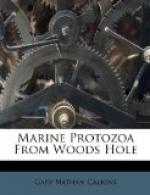Fresh and salt water.
Aspidisca hexeris Quennerstedt ’67. Fig. 56.
The carapace is elliptical, about 1-1/2 times as long as broad, rounded at the extremities. The left border of the carapace bears a spur-like projection. The ventral cirri are short and thick, and are very characteristic of the species. When moving slowly they look much like nicely-pointed paint brushes, but when the animal is compressed they quickly become fibrillated, and then look like extremely old and worn brushes. These cirri are placed in depressions in the ventral surface and each one appears to come from a specific shoulder. At the posterior end an oblique hollow bears 6 unequal cirri placed side by side. The extreme right cirrus is the largest, and they become progressively smaller to the opposite end. Dorsal to these lies the contractile vacuole. The peristome is in the posterior half of the body and an undulating membrane extends from it into the oesophagus. The dorsal surface is longitudinally striated by 5 or 6 lines, which are usually curved. The nucleus is horseshoe-shaped and lies in the posterior half of the body. Length 68 mu; diameter 48 mu.
[Illustration: Fig. 56.—Aspidisca hexeris.]
This form was incorrectly mentioned as Mesodinium sp. by Peck ’95:
In the figure given by Quennerstedt there are only 7 ventral cirri. In the Woods Hole form there are 8, 7 of which are anterior, 6 of them about one central one. The eighth cirrus is by itself, near the base of the largest posterior cirrus. These cirri, in spite of their size, are easily overlooked and more easily confused, but by using methylene blue they can be seen and counted.
Aspidisca polystyla Stein. Fig. 57.
This species is similar to A. hexeris, but is smaller, very transparent, and without the spur-like process on the left edge of the carapace. The chief difference, however, lies in the number of anal cirri. These are 10 in number and they are arranged obliquely as in the preceding species, with the largest one on the right and the smallest on the left. The ventral cirri are 8 in number, and are arranged in two rows, one of which, the right, has 4 cirri closely arranged, the other having 3 cirri close together and one at some distance, near the largest anal cirrus. The peristome, contractile vacuole, and nucleus are similar to the preceding. Length 36 mu; width 22 mu.
[Illustration: Fig. 57.—Aspidisca polystyla.]
Stein assigns only 7 ventral cirri to this species, but he also describes 2 very fine bristle like cilia (p. 125) and pictures them in figs. 18, 19, 20, and 21 of his Taf. III in the same relative position as my eighth cirrus. I am positive that cilia do not occur on the ventral face of this form, and that the characteristic cirri are the sole locomotor organs.




